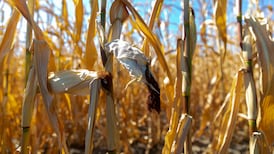ANOTHER LIFE: RACHEL CARSON, the United States' early begetter of the environmental movement, knew about much more than the ominous silencing of spring by the toxins of DDT.
Her own science was marine biology, and her great early trilogy of books on the ocean has been my frequent inspiration, offering a flow of learning lit up by a loving absorption in “the mystery and meaning of the sea”, nurtured by her research across the Atlantic from Co Mayo.
In The Edge of the Sea (1955) she described finding a stranded Portuguese man-of-war on a South Carolina beach and, having kept it respectfully overnight in a bucket of saltwater, waded into a chilly March sea to hurl it (and its deadly stinging tentacles) as far as she could into the waves.
What struck her was the man-of-war’s behaviour as it fought to leave the shallows, trying to use a difficult wind by adjusting the shape and position of the colony’s gas-filled sail, set diagonally across its base. There was, she said, “a strong illusion of sentience. This was no helpless bit of flotsam, but a living creature exerting every means at its disposal to control its fate”.
When, these days, this common creature of the Gulf Stream arrives near Irish shores, we may think of global warming and the steady northward shift of warm-water species – perhaps even of dire predictions about jellyfish taking over an ocean emptied of fish for human food. But occasional “invasions” of Physalia physalis around these islands have been recorded for a century or more. The last was in 2009, when more than 30 sightings along the east coast presaged much larger numbers out in the Irish Sea. The same may be true off the south coast this year. Swarms of anything up to 1,000 float in warmer tropical waters, and can be carried to these shores by a seasonal abundance of southwest winds in the great, warm river of the Gulf Stream.
The Portuguese man-of-war (originally named, apparently, for the resemblance of its float to the helmets of Portuguese soldiers) is technically not a single jellyfish but a siphonophore, an elongated, joined-up colony of individual organisms or zooids, each with a different function but working together as a team. Communication between them is maintained through a network of nerve fibres. None could lead an independent life.
The most visible zooid is the sail, or float, and its base. The oddly martial-looking sail is an iridescent party balloon, pink or blue or both, according to the light, and filled from a gland that pumps out nitrogen and carbon monoxide, with a moiety of argon, to stretch the balloon to perhaps 30cm.
While some siphonophores can deflate their float completely, sinking beneath the surface if the weather turns rough, the Physalia colony is limited to pumping it up or down to affect the speed of drift. How far it can “consciously” manipulate its voyage, as inferred by Rachel Carson, is part of marine biology’s continuing research into the animal’s mysteries.
Each of its long, trailing fishing tentacles – extending up to 30m in the larger specimens – is studded with notoriously powerful stinging cells, or nematocysts, that paralyse the little larval fish that form up to 90 per cent of its diet. They capture, on average, some 120 larvae in a day.
The colony’s third set of zooids are shorter, thinner tentacles with flexible mouths that digest captured prey. Nutrients from the meal are shared through a common gut system that connects all members of the colony.
Lastly, there are even shorter tentacles, gonozooids, which have all the information needed to reproduce all the other parts of the colony.
Colonies are either male or female, and to avoid inbreeding they form large breeding shoals where eggs and sperm are released, fusing to form larvae.
Though the pain to human swimmers who brush against Physalia’s fishing tentacles can be hazard enough, fatalities are rare. The first on medical record came as late as 1987, when a swimmer on the Florida coast died, despite first aid on the beach, from respiratory failure and cardiovascular collapse. Consequences are usually far milder, and can be gleaned from the odd man-of-war poem on the net, as in Rosalind Brackenbury’s lines: “Pain works its flower / and bloom in you / and won’t let up, you will walk / for days with its tattoed / necklaces upon your skin . . .”
For more prosaic but practical information, the Jellyfish Action Group of Ireland and Wales, helped by experts from Irish hospital emergency departments, offers advice at firstaidforeveryone.ieor jellyfish.ie.
Eye on nature
The annual swarm of ants took place here recently. We watched dozens of black-headed terns swooping around: they seemed to be feeding on the flying ants. Could this be possible?RJ Molloy, Waterford
Black-headed gulls also feed on flying ants.
I have noticed a strange substance in my garden. It appears in patches of material resembling melted cheese or semolina.Máire Nic Mhaoláin, Dalkey, Co Dublin
The substance is Fuligo septica, called scrambled-egg mould among several other less attractive names. It is a slime mould that is neither animal nor vegetable but has characteristics of both, being able to move in search of food by means of contractions. Normally hidden in leaf mould or decaying matter, slime mould can be brought into the open by warm humid weather.
On September 1st I watched male St Mark's flies (Bibio marci) jostle for position above a hedge, their strangely long legs dangling as they hovered in mating pattern.Peter Lynch, Blackrock, Co Dublin
They normally appear in April and start their breeding cycle. They must have read the signs wrongly.
I have watched slugs eating carrion, even of their own kind. Recently, however, I saw a slug investigate a dead wasp before deciding that discretion was the better part of valour.Guy Stephenson, Letterkenny, Co Donegal
Michael Viney welcomes observations at Thallabawn, Carrowniskey PO, Westport, Co Mayo. Email viney@anu.ie. Please include a postal address









